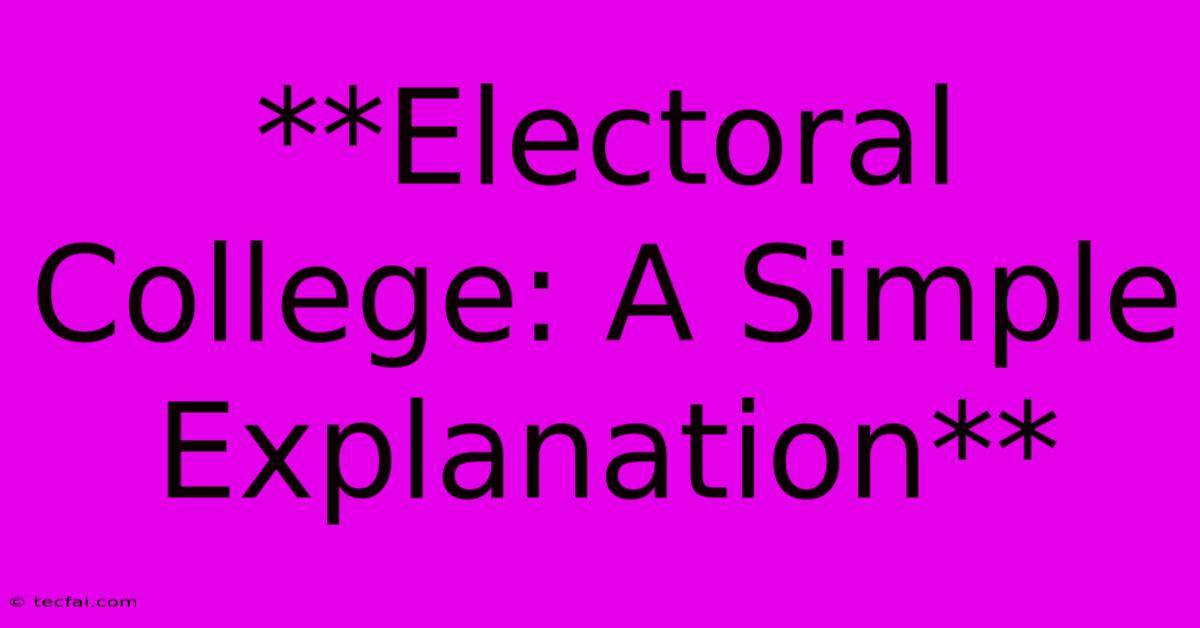**Electoral College: A Simple Explanation**

Discover more detailed and exciting information on our website. Click the link below to start your adventure: Visit Best Website tecfai.com. Don't miss out!
Table of Contents
Electoral College: A Simple Explanation
The Electoral College is a unique system used in the United States to elect the President and Vice President. It's often a source of confusion and debate, particularly during close elections. This article provides a straightforward explanation of how the Electoral College works and explores its pros and cons.
How the Electoral College Works
The Electoral College system essentially acts as an intermediary between the popular vote and the presidency. Here's a breakdown:
-
Each state is assigned a specific number of electors based on its population. This number equals the sum of its U.S. Senators (always two) and Representatives in the House. Larger states, like California, have more electors than smaller states like Wyoming.
-
The District of Columbia also receives three electors, equivalent to a small state.
-
During the presidential election, voters cast ballots for their preferred candidate. However, these votes are not directly for the president. Instead, they determine which candidate wins the state's electoral votes.
-
Except for Maine and Nebraska, the winner of the popular vote in a state wins all of that state's electoral votes. This is known as the "winner-take-all" system.
-
The candidate who receives at least 270 electoral votes out of a total of 538 wins the presidency.
Why Was the Electoral College Created?
The founding fathers established the Electoral College for several reasons:
-
To protect smaller states: The winner-take-all system ensures that smaller states have a voice in the presidential election. Without it, candidates would focus solely on populous states, potentially neglecting the concerns of smaller states.
-
To prevent "mob rule": The founders feared that a direct popular vote could lead to unqualified or unrepresentative candidates winning the presidency. The Electoral College aimed to create a system where more experienced and qualified individuals were selected.
-
To promote a more informed electorate: The Electoral College encourages candidates to campaign in diverse regions of the country, potentially exposing voters to a wider range of political perspectives.
Pros and Cons of the Electoral College
Pros:
-
Protects smaller states: As mentioned above, the Electoral College system ensures that smaller states have a meaningful role in presidential elections.
-
Encourages broader campaigning: Candidates are motivated to campaign in states with varying demographics, leading to greater national focus.
-
Stability and compromise: The system can help to promote stability and compromise between different regions of the country.
Cons:
-
Possible discrepancy between popular vote and electoral vote: It's possible for a candidate to win the presidency despite losing the popular vote, which can be seen as undemocratic.
-
Discourages voter turnout in states considered "safe" for one party or the other: In states where one party consistently wins, voters may feel their vote doesn't matter, leading to lower voter turnout.
-
Potential for electoral manipulation: The winner-take-all system could be vulnerable to manipulation in certain circumstances, such as gerrymandering or voter suppression.
The Future of the Electoral College
The Electoral College remains a subject of heated debate. Some argue for its abolition, while others support its retention. Arguments for reform often center on addressing the potential for a candidate to win the presidency without winning the popular vote. It's likely that the discussion around the Electoral College will continue for many years to come, as its place in American politics remains a topic of ongoing debate.

Thank you for visiting our website wich cover about **Electoral College: A Simple Explanation** . We hope the information provided has been useful to you. Feel free to contact us if you have any questions or need further assistance. See you next time and dont miss to bookmark.
Featured Posts
-
Ac Milan Vs Real Madrid Live Stream Tv Schedule
Nov 06, 2024
-
Bank Of China Expands To Papua New Guinea
Nov 06, 2024
-
Haaland Held Silent As Sporting Upsets City
Nov 06, 2024
-
Steelers Trade For Jets Wr Mike Williams Add Preston
Nov 06, 2024
-
Jill Stein Green Party Platform And Policies
Nov 06, 2024
